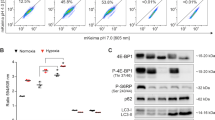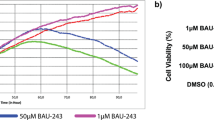Abstract
In TNF-related apoptosis-inducing ligand (TRAIL)-resistant glioma cells, co-treatment with nontoxic doses of sodium butyrate and TRAIL resulted in a marked increase of TRAIL-induced apoptosis. This combined treatment was also cytotoxic to glioma cells overexpressing Bcl-2 or Bcl-xL, but not to normal human astrocytes, thus offering an attractive strategy for safely treating resistant gliomas. Cotreatment with sodium butyrate facilitated completion of proteolytic processing of procaspase-3 that was partially blocked by treatment with TRAIL alone. We also found that treatment with sodium butyrate significantly decreased the protein levels of survivin and X-linked inhibitor of apoptosis protein (XIAP), two major caspase inhibitors. Overexpression of survivin and XIAP attenuated sodium butyrate-stimulated TRAIL-induced apoptosis, suggesting its involvement in conferring TRAIL resistance to glioma cells. Furthermore, the kinase activities of Cdc2 and Cdk2 were significantly decreased following sodium butyrate treatment, accompanying downregulation of cyclin A and cyclin B, as well as upregulation of p21. Forced expression of Cdc2 plus cyclin B, but not Cdk2 plus cyclin A, attenuated sodium butyrate/TRAIL-induced apoptosis, overriding sodium butyrate-mediated downregulation of survivin and XIAP. Therefore, Cdc2-mediated downregulation of survivin and XIAP by sodium butyrate may contribute to the recovery of TRAIL sensitivity in glioma cells.
This is a preview of subscription content, access via your institution
Access options
Subscribe to this journal
Receive 50 print issues and online access
$259.00 per year
only $5.18 per issue
Buy this article
- Purchase on Springer Link
- Instant access to full article PDF
Prices may be subject to local taxes which are calculated during checkout











Similar content being viewed by others
References
Ashkenazi A, Pai RC, Fong S, Leung S, Lawrence DA, Marsters SA, Blackie C, Chang L, McMurtrey AE, Hebert A, DeForge L, Koumenis IL, Lewis D, Harris L, Bussiere J, Koeppen H, Shahrokh Z and Schwall RH . (1999). J. Clin. Invest., 104, 155–162.
Atadja P, Gao L, Kwon P, Trogani N, Walker H, Hsu M, Yeleswarapu L, Chandramouli N, Perez L, Versace R, Wu A, Sambucetti L, Lassota P, Cohen D, Bair K, Wood A and Remiszewski S . (2004). Cancer Res., 64, 689–695.
Bernhard D, Ausserlechner MJ, Tonko M, Loffler M, Hartmann BL, Csordas A and Kofler R . (1999). FASEB J., 13, 1991–2001.
Boatright KM and Salvesen GS . (2003). Curr. Opin. Cell Biol., 15, 725–731.
Brugarolas J, Moberg K, Boyd SD, Taya Y, Jacks T and Lees JA . (1999). Proc. Natl. Acad. Sci. USA, 96, 1002–1007.
Chakravarti A, Noll E, Black PM, Finkelstein DF, Finkelstein DM, Dyson NJ and Loeffler JS . (2002). J. Clin. Oncol., 20, 1063–1068.
Chen JS, Faller DV and Spanjaard RA . (2003). Curr. Cancer Drug Targets, 3, 219–236.
Chopin V, Slomianny C, Hondermarck H and Le Bourhis X . (2004). Exp. Cell. Res., 298, 560–573.
Deveraux QL and Reed JC . (1999). Genes Dev., 13, 239–252.
Deveraux QL, Leo E, Stennicke HR, Welsh K, Salvesen GS and Reed JC . (1999). EMBO J., 18, 5241–5251.
Earnshaw WC, Martins LM and Kaufmann SH . (1999). Annu. Rev. Biochem., 68, 383–424.
Gui CY, Ngo L, Xu WS, Richon VM and Marks PA . (2004). Proc. Natl. Acad. Sci. USA, 101, 1241–1246.
Guo F, Sigua C, Tao J, Bali P, George P, Li Y, Wittmann S, Moscinski L, Atadja P and Bhalla K . (2004). Cancer Res., 64, 2580–2589.
Han Z, Hendrickson EA, Bremner TA and Wyche JH . (1997). J. Biol. Chem., 272, 13432–13436.
Heerdt BG, Houston MA and Augenlicht LH . (1994). Cancer Res., 54, 3288–3293.
Heerdt BG, Houston MA and Augenlicht LH . (1997). Cell Growth Differ., 8, 523–532.
Hernandez A, Thomas R, Smith F, Sandberg J, Kim S, Chung DH and Evers BM . (2001). Surgery, 130, 265–272.
Huang DC, Cory S and Strasser A . (1997). Oncogene, 14, 405–414.
Ito N, Sawa H, Nagane M, Noguchi A, Hara M and Saito I . (2001). Neurosurgery, 49, 430–436.
Kamitani H, Taniura S, Watanabe K, Sakamoto M, Watanabe T and Eling T . (2002). Neuro-oncology, 4, 95–101.
Katula KS, Wright KL, Paul H, Surman DR, Nuckolls FJ, Smith JW, Ting JP, Yates J and Cogswell JP . (1997). Cell Growth Differ., 8, 811–820.
Kim EH, Kim SU, Shin DY and Choi KS . (2004b). Oncogene, 23, 446–456.
Kim SU, Moretto G, Lee V and Yu RK . (1986). J. Neurosci. Res., 15, 303–321.
Kim SU . (1985). J. Neuroimmunol., 8, 255–282.
Kim YH, Park JW, Lee JY and Kwon TK . (2004a). Carcinogenesis, 25, 1813–1820.
Kirsch DG, Doseff A, Chau BN, Lim DS, de Souza-Pinto NC, Hansford R, Kastan MB, Lazebnik YA and Hardwick JM . (1999). J. Biol. Chem., 274, 21155–21161.
Knight MJ, Riffkin CD, Muscat AM, Ashley DM and Hawkins CJ . (2001). Oncogene, 20, 5789–5798.
Kobayashi K, Hatano M, Otaki M, Ogasawara T and Tokuhisa T . (1999). Proc. Natl. Acad. Sci. USA, 96, 1457–1462.
Kramer A, Carstens CP, Wasserman WW and Fahl WE . (1997). Cancer Res., 57, 5117–5121.
Kruh J . (1982). Mol. Cell Biochem., 42, 65–82.
Legler JM, Ries LA, Smith MA, Warren JL, Heinmann EF, Kaplan RS and Linnet MS . (1999). J. Natl. Cancer Inst., 91, 1382–1390.
Lipinski CA, Tran NL, Bay C, Kloss J, McDonough WS, Beaudry C, Berens ME and Loftus JC . (2003). Mol. Cancer Res., 1, 323–332.
Marks PA, Richon VM, Breslow R and Rifkind RA . (2001). Curr. Opin. Oncol., 13, 477–483.
Misra A, Chattopadhyay P, Dinda AK, Sarkar C, Mahapatra AK, Hasnain SE and Sinha S . (2000). J. Neurooncol., 48, 1–12.
Nair AR, Boersma LJ, Schiltz L, Chaudhry MA and Muschel RJ . (2001). Cancer Lett., 166, 55–64.
Nakata S, Yoshida T, Horinaka M, Shiraishi T, Wakada M and Sakai T . (2004). Oncogene, 23, 6261–6271.
Neuzil J, Swettenham E and Gellert N . (2004). Biochem. Biophys. Res. Commun., 314, 186–191.
Nicholson DW, Ali A, Thornberry NA, Vaillancourt JP, Ding CK, Gallant M, Gareau Y, Griffin PR, Labelle M, Lazebnik YA, Munday NA, Raju SM, Smulson ME, Yamin TT and Miller DK . (1995). Nature, 376, 37–43.
Nomura T, Mimata H, Takeuchi Y, Yamamoto H, Miyamoto E and Nomura Y . (2003). Urol. Res., 31, 37–44.
Pellizzaro C, Coradini D, Daniotti A, Abolafio G and Daidone MG . (2001). Int. J. Cancer, 91, 654–657.
Piekarz R and Bates S . (2004). Curr. Pharm. Des., 10, 2289–2298.
Rokudai S, Fujita N, Hashimoto Y and Tsuruo T . (2000). J. Cell Physiol., 182, 290–296.
Rosato RR, Almenara JA, Dai Y and Grant S . (2003). Mol. Cancer Ther., 2, 1273–1284.
Sawa H, Murakami H, Ohshima Y, Murakami M, Yamazaki I, Tamura Y, Mima T, Satone A, Ide W, Hashimoto I and Kamada H . (2002). Brain Tumor Pathol., 19, 77–81.
Seol DW, Li J, Seol MH, Park SY, Talanian RV and Billiar TR . (2001). Cancer Res., 61, 1138–1143.
Shankar S and Srivastava RK . (2004). Drug Resist. Update, 7, 139–156.
Siavoshian S, Segain JP, Kornprobst M, Bonnet C, Cherbut C, Galmiche JP and Blottiere HM . (2000). Gut, 46, 507–514.
Suliman A, Lam A, Datta R and Srivastava RK . (2001). Oncogene, 20, 2122–2133.
Sun XM, Bratton SB, Butterworth M, MacFarlane M and Cohen GM . (2002). J. Biol. Chem., 277, 11345–11351.
Suzuki Y, Nakabayashi Y and Takahashi R . (2001). Proc. Natl. Acad. Sci. USA, 98, 8662–8667.
Tewari M, Beidler DR and Dixit VM . (1995). J. Biol. Chem., 270, 18738–18741.
Vigushin DM and Coombes RC . (2002). Anticancer Drugs, 13, 1–13.
Vigushin DM, Ali S, Pace PE, Mirsaidi N, Ito K, Adcock I and Coombes RC . (2001). Clin. Cancer Res., 7, 971–976.
Walczak H, Miller RE, Ariail K, Gliniak B, Griffith TS, Kubin M, Chin W, Jones J, Woodward A, Le T, Smith C, Smolak P, Goodwin RG, Rauch CT, Schuh JC and Lynch DH . (1999). Nat. Med., 5, 157–163.
Wang S and El-Deiry WS . (2003). Oncogene, 22, 8628–8633.
Wiley SR, Schooley K, Smolak PJ, Din WS, Huang CP, Nicholl JK, Sutherland GR, Smith TD, Rauch C, Smith CA and Goodwin RG . (1995). Immunity, 3, 673–682.
Yokota T, Matuszaki Y, Miyazawa K, Zindy F, Roussel MF and Sakai T . (2004). Oncogene, 23, 5340–5349.
Zaffaroni N and Daidone MG . (2002). Drug Resist. Update, 5, 65–72.
Zhang XD, Gillespie SK, Borrow JM and Hersey P . (2003). Biochem. Pharmacol., 66, 1537–1545.
Zhou Q, Snipas S, Orth K, Muzio M, Dixit VM and Salvesen GS . (1997). J. Biol. Chem., 272, 7797–8000.
Acknowledgements
We thank Professor A Strasser (The Walter and Eliza Hall Institute of Medical Research) for providing us with Bcl-2 and Bcl-xL expression vector; Professor VM Dixit (University of Michigan Medical School) for CrmA expression vector; and Professor T Tokuhisa (Chiba University) for a flag/survivin fusion protein expression vector; Professor Y Nomura (Oita Medical University) for XIAP expression vector; Dr S van den Heuvel (Massachusetts General Hospital) for plasmids expressing Cdc2 and Cdk2; Dr P Robbins (University of Pittsburgh) for plasmids expressing cyclin A and cyclin B; Dr DY Shin (Dankook University college of Medicine) for the reporter constructs containing the promoters of human cyclin A and cyclin B1; Dr B Vogelstein for human colon cancer cell lines, HCT116 wild-type cells and HCT116 p21−/− cells. This study was supported by grants from the National R & D Program for Cancer Control (2003), Ministry of Health & Welfare, Korea and the KOSEF/BDRC Ajou University (R11-1998-052-08009).
Author information
Authors and Affiliations
Corresponding author
Additional information
Supplementary Information accompanies the paper on Oncogene website (http://www.nature.com/onc)
Supplementary information
Rights and permissions
About this article
Cite this article
Kim, E., Kim, H., Kim, S. et al. Sodium butyrate sensitizes human glioma cells to TRAIL-mediated apoptosis through inhibition of Cdc2 and the subsequent downregulation of survivin and XIAP. Oncogene 24, 6877–6889 (2005). https://doi.org/10.1038/sj.onc.1208851
Received:
Revised:
Accepted:
Published:
Issue Date:
DOI: https://doi.org/10.1038/sj.onc.1208851



